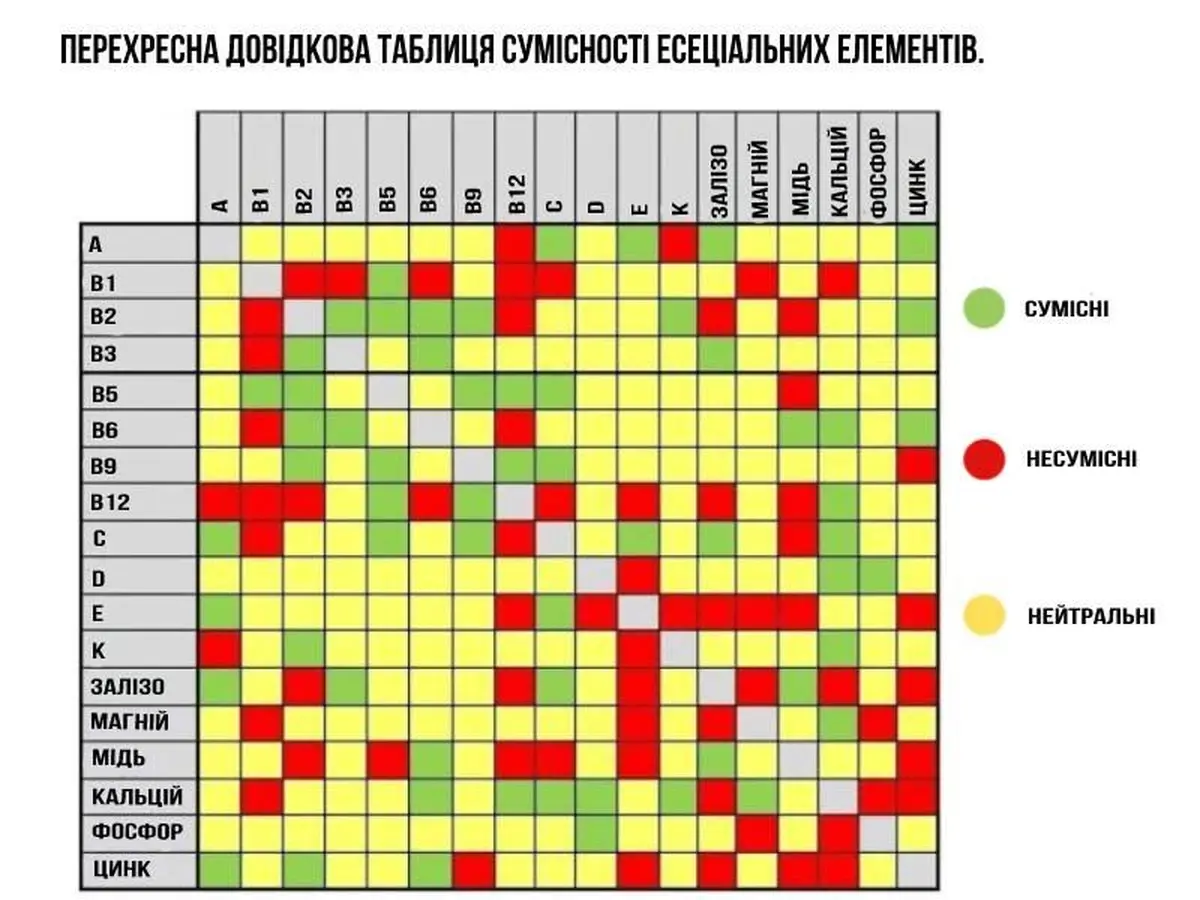 Everything we consume interacts not only with our bodies but also with other substances that enter our system. Doctors explain why not all vitamins and minerals work equally well when taken together and which dietary supplements should not be combined due to their opposing effects. To maximize the benefits of vitamins and other micronutrients, it’s essential to consider the principles of synergy and antagonism. In the case of synergy, the combined action of substances enhances the positive effect of each. Conversely, in antagonism, opposing substances hinder each other’s effectiveness. Besides following the rules for combining , it’s also important not to violate the conditions of their intake.
Everything we consume interacts not only with our bodies but also with other substances that enter our system. Doctors explain why not all vitamins and minerals work equally well when taken together and which dietary supplements should not be combined due to their opposing effects. To maximize the benefits of vitamins and other micronutrients, it’s essential to consider the principles of synergy and antagonism. In the case of synergy, the combined action of substances enhances the positive effect of each. Conversely, in antagonism, opposing substances hinder each other’s effectiveness. Besides following the rules for combining , it’s also important not to violate the conditions of their intake.
Harmonious Combinations
When doctors recommend taking certain supplements together while advising others to be taken separately, they are guided by the principles of synergy and antagonism. For instance, vitamin B6 aids in the absorption of magnesium into cells, while iron reduces the absorption of zinc when both micronutrients are consumed together. Therefore, it’s crucial to understand the compatibility of vitamins and minerals and to know whether they “get along” or “fight” with each other.
Vitamin B6 + Magnesium
Let’s start with the “friends.” The compatibility of B vitamins is particularly “friendly.” For example, vitamin B6, when taken with , enhances the absorption of this mineral, which regulates nerve and muscle activity, participates in protein synthesis, and influences over 300 functions in the human body. This vitamin supports the nervous and immune systems, hemoglobin production, metabolism, protein synthesis, skin and hair health, and helps convert food into energy.
Vitamin B12 + Vitamin B9
Another example of a compatible combination is the pairing of vitamins B12 and B9. Vitamin B12 supports the nervous system and the production of red blood cells, while folic acid (vitamin B9) aids in DNA synthesis , ensures a healthy pregnancy, and promotes cardiovascular health. Together, these vitamins undoubtedly enhance each other’s effects.
Vitamin C + Iron
The antioxidant properties and immune-boosting abilities of vitamin C are remarkable. Additionally, it improves the absorption of iron, which is essential for transporting oxygen in the blood, strengthening immunity, and promoting healthy hair, nails, and skin.
Vitamin D + K2
These vitamins work together to support bone health and cardiovascular wellness. Vitamin D aids in the absorption of calcium from food, maintaining optimal levels in the blood. Meanwhile, vitamin K2, in conjunction with vitamin D, directs calcium to the and bones, preventing its accumulation in the arteries.
Vitamin E + Omega-3
Omega-3 fatty acids support mood, heart health, brain function, skin, eyes, and metabolism. Vitamin E acts as an antioxidant, protecting cells from damage. The combined action of vitamin E and omega-3 enhances their effectiveness and absorption.

Unwanted Combinations
The following combinations are considered detrimental, as these supplements are poorly absorbed together or even neutralize each other’s effects. Doctors advise against combining these nutrients and recommend taking them separately, with at least a two-hour gap.
Zinc + Copper
This is an unfortunate combination because high doses of zinc hinder the absorption of copper.
Iron + Zinc
When taken together in large doses, iron reduces the absorption of zinc.
Calcium + Iron
Taking these minerals together will cause calcium in the intestines to lower the absorption of iron.
Magnesium + Calcium
High doses of these minerals also negatively affect each other’s absorption.
Vitamin C + Vitamin B12
If you don’t want to take vitamins in vain, avoid this combination as it neutralizes the effects of the elements in this complex.
Supplement Intake Guidelines
Before starting to take vitamins and other supplements, it’s essential to consult with a doctor and follow their dosage recommendations. It’s also helpful to read reviews from other patients, check the manufacturer, learn about the product’s composition, and read the instructions on the packaging. Using tracking stickers can help you remember to take your vitamins. Separate incompatible nutrients by at least two hours. Store compatible micronutrients in pairs, in separate containers, ensuring they are kept at the proper temperature and away from direct sunlight. A special compatibility chart for vitamins and minerals can help you navigate combinations, where yellow indicates neutral interaction, green indicates compatibility, and red indicates incompatibility.

Photo: Unsplash
